Key Points
-
Dividend stocks have historically outperformed non-dividend paying stocks.
-
Target proved to investors it could compete digitally during the COVID-19 pandemic.
-
Ford Pro is a growing high-margin business segment for the automaker.
- 10 stocks we like better than Ford Motor Company ›
“I do not own a single security anywhere that doesn’t pay a dividend, and I formed a mutual-fund company with that very simple philosophy.” – Canadian entrepreneur and investor Kevin O’Leary
Dividend stocks have historically outperformed non-dividend paying stocks.
Target proved to investors it could compete digitally during the COVID-19 pandemic.
Ford Pro is a growing high-margin business segment for the automaker.
“I do not own a single security anywhere that doesn’t pay a dividend, and I formed a mutual-fund company with that very simple philosophy.” – Canadian entrepreneur and investor Kevin O’Leary
Dividend stocks are popular investing options that historically outperform non-dividend-paying stocks. They tend to offer investors a steady and transparent income stream, and are often more resilient to economic downturns.
Where to invest $1,000 right now? Our analyst team just revealed what they believe are the 10 best stocks to buy right now. Continue »
Let’s take a look at two high-yield dividend stocks paying investors handsomely to risk near-term headwinds in the businesses.

Image source: Ford Motor Company.
Target can help investors hit their dividend targets
Target (NYSE: TGT) has huge name recognition thanks to its position as the U.S.’s seventh-largest retailer. It offers a more upscale in-store shopping experience and a range of products from apparel, home goods, and essentials. It also boasts over 1,900 stores in the U.S. and generates over $100 billion annually in sales.
The popular retailer is under pressure of late amid a weaker consumer spending environment and tough competition, but the company does have some tailwinds. Target should benefit from the ongoing decline of mall-based competition and department stores, which should help drive same-store sales higher in the medium term. Further, Target focuses on a more affluent customer with an average household income of roughly $79,000, according to GlobalData, much higher than rival Walmart at $62,000.
Target also quelled some fears that the retailer couldn’t compete online with the likes of juggernauts Amazon and Walmart, because during the COVID-19 pandemic, it managed to navigate difficult waters through in-store renovations and digital growth — its sales surged 40% from 2019 through 2022.
Data by YCharts.
Also helping in that department is Target’s advantageous locations. The retailer’s stores are located within 10 miles of 75% of the U.S. population, enabling a “stores as hubs” distribution business where stores can fulfill 97% of total sales.
Target’s dividend is considered safe and reliable in part because the company has a 54-year streak of dividend growth, making it a Dividend King. Its dividend payout ratio, around 55%, is quite manageable and supported by consistent profitability and strong free cash flow.
While headwinds will remain in the near future, its iconic brand, more affluent consumers, and a more upscale experience compared to low-cost retailers, should continue driving foot traffic long term. Despite the headwinds, Target feels too cheap to ignore trading at a price-to-earnings multiple of 11 times, and offering investors a juicy 5.1% dividend yield.
Ford Pro gives Ford Motor a solid base to work from
Ford Motor Company (NYSE: F) has a lot on its plate right now. The vehicle manufacturer is currently busy setting a full-year record for recalls, which have reared their ugly head in the recent past and dinged earnings. It’s also facing increasing competition in China, tariff uncertainty, and currently wildly unprofitable electric vehicles. That said, the company has made substantial improvements in closing the cost gap between itself and its rivals.
“We recorded our fourth consecutive quarter of year-over-year cost improvement, excluding the impact of tariffs, building on progress we made last year when we closed roughly $1.5 billion of our competitive cost gap in material cost. Our balance sheet keeps getting stronger, further enabling our ability to invest in areas of strength. We are remaking Ford into a higher-growth, higher-margin, and more durable business … ,” said Ford CFO Sherry House in an earnings press release.
Speaking of those higher margins, let’s highlight the shining star of Ford’s business currently: Ford Pro, responsible for its commercial sales. Consider that the Ford Pro segment generated $3.6 billion earnings before interest and taxes during the first half of 2025 at a strong 10.7% EBIT margin. That compares very favorably to its Ford Blue segment, responsible for its traditional business, which posted $757 million EBIT during the first half of 2025, at a more paltry 1.6% EBIT margin. In fairness, both of those segments compare favorably to its Model e division, responsible for its electric vehicles, which lost more than $2.1 billion during the first half of 2025.
The good news is that Ford Pro stands to improve its high-margin business as software, physical services, and paid subscriptions grow. Ford Pro paid subscriptions grew 24% year over year to 757,000.
Ford has problems to solve, but it’s a tempting investment as it trades at a modest price-to-earnings ratio of 15 times and offers investors not only a 5.1% dividend yield, but often dishes out an annual supplemental dividend to further return value to shareholders. The business also operates in such a way that Ford’s dividend is considered reliable and safe.
Are both buys now?
We have to be fair about this; neither of these stocks is an absolute no-brainer investment. Both face very real headwinds, operate in cutthroat retail industries, and lack durable competitive advantages. However, especially for income investors, the upside at these valuations is likely worth a small position, with both companies offering safe dividends yielding 5%-plus.
Should you invest $1,000 in Ford Motor Company right now?
Before you buy stock in Ford Motor Company, consider this:
The Motley Fool Stock Advisor analyst team just identified what they believe are the 10 best stocks for investors to buy now… and Ford Motor Company wasn’t one of them. The 10 stocks that made the cut could produce monster returns in the coming years.
Consider when Netflix made this list on December 17, 2004… if you invested $1,000 at the time of our recommendation, you’d have $650,607!* Or when Nvidia made this list on April 15, 2005… if you invested $1,000 at the time of our recommendation, you’d have $1,114,716!*
Now, it’s worth noting Stock Advisor’s total average return is 1,068% — a market-crushing outperformance compared to 190% for the S&P 500. Don’t miss out on the latest top 10 list, available when you join Stock Advisor.
*Stock Advisor returns as of September 29, 2025
Daniel Miller has positions in Ford Motor Company. The Motley Fool has positions in and recommends Amazon, Target, and Walmart. The Motley Fool has a disclosure policy.
